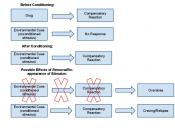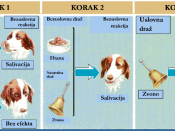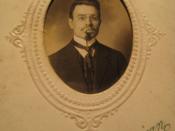Abstract This study attempted to replicate the work of Ivan Pavlov with higher-order classical conditioning. I formed an experiment based on Pavlov's S-R (stimulus-response) model of conditioning in order to test the theory that a subject could be trained to elicit a response to a certain smell. The participant (1 college graduate aged 26; male) underwent ten weeks of conditioning with the aim of associating blinking their eyes with a certain perfume. The results were successful. The participant was conditioned to respond to a certain perfume after only forty-two trials (six weeks). In addition, the limitations to classical conditioning were assessed, the possibility of stimulus discrimination was analyzed, and stimulus saliency, contingency, contiguity, and informativeness were studied. These successful results merely verify the work of Pavlov and the theories we depend on today.
Introduction So, how did the concept of classical conditioning come about? It all began with Ivan Pavlov in the early 1900's.
Pavlov was conducting experiments to determine how saliva affected digestion in dogs. His experiment was based upon placing meat powder into a dog's mouth, and seeing how much it would salivate, and what effect this would have on the dog's digestive system. Initially, the dogs started salivating only upon tasting or seeing the food, but Pavlov found that over time, merely the sight of the experimenters that brought the dog food caused the animal to salivate. This led Pavlov to alter his experiment to study this phenomenon. Now, whenever the food was presented, Pavlov would ring a bell close to the dog. Shortly after this change in the feeding patterns, it was found that merely hearing the bell would also cause the dog to salivate. It was found that the dogs had automatically paired the bell with the food, in the same way as it had linked the lab assistants to its food. Hence, a conditioned response had been created. This response to the bell (a Conditioned response) was caused through the repetitive pairing of the bell (a Neutral stimulus) with the dog's food (an unconditioned stimulus). This experiment is the first reported example of classical conditioning.
In order to define classical conditioning, we must look at the different components that are involved: from acquisition to extinction.
Acquisition is the process of developing and strengthening a conditioned response through the repetitive pairings of a neutral stimulus with an unconditioned stimulus. In essence, acquisition is the entire process of conditioning. It involves taking a neutral stimulus, such as a metronome and pairing it with a conditioned stimulus, such as food and eliciting a response, for example, drooling.
Once acquisition is complete, and conditioning has been successful, extinction begins. During the process of extinction a conditioned response is weakened or eliminated when the conditioned stimulus is repeatedly presented in the absence of the unconditioned stimulus. What this means is: once the metronome elicits a drooling response, extinction begins to occur. The metronome is presented constantly without the food and eventually the unconditioned response of drooling is no longer linked with the noise.
The third and final phase of classical conditioning is spontaneous recovery. Spontaneous recovery is the reappearance of a conditioned response following a rest period after extinction. Spontaneous recovery happens a few times, but eventually dies out.
There are two different types of classical conditioning: S-R (stimulus-response) conditioning (which takes place in my experiment) and S-S (stimulus-stimulus) conditioning. In S-R conditioning the neutral stimulus becomes directly associated with the unconditioned response and therefore comes to elicit the same response as the unconditioned response. In S-S conditioning; however, the neutral stimulus becomes directly associated with the unconditioned stimulus and, because of this association, comes to elicit a response that is related to the unconditioned stimulus.
There are three conditions that are necessary for conditioning to occur: 1) contingency - probability 2) contiguity - the relationship between the conditioned stimulus and the unconditioned stimulus in time and 3) informativeness - whether the conditioned stimulus yields new information. These three circumstances are required in order to have a reliable study, and one that can be generalized throughout the population. They are very important to my study.
There are also limitations to classical conditioning: 1) overshadowing - the most salient member of the compound stimulus is more readily conditioned and interferes with the conditioning of the less salient members 2) blocking - the presence of an established conditioned stimulus interferes with the conditioning of a new conditioned stimulus and 3) latent inhibition - a familiar stimulus is more difficult to condition than an unfamiliar stimulus . Due to the fact that I only used one conditioned stimulus, and not a compound stimulus, the only limitation I had to watch for was latent inhibition. The effects of this were determined by gathering baseline information, such as what perfumes he was accustomed to smelling.
In my study, I shall evaluate the experimental process of classical conditioning by gathering and analyzing data related to the subject output in my individual observational setting. Taking into account the various factors affecting classical conditioning, I am led to predict that this individual will be successfully conditioned. More specifically, I propose that the participant in my study will learn to associate the smell of my perfume with the involuntary act of blinking, hopefully within ten weeks of beginning the experiment.





